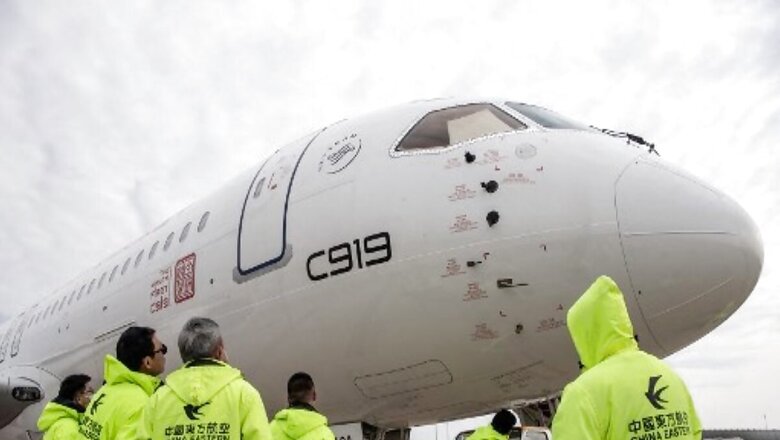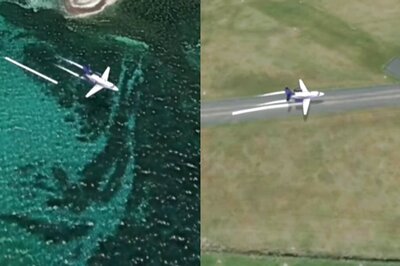
views
For long, Boeing and Airbus have dominated the manufacturing of large commercial aircraft. There are other players in regional jets which are smaller aircraft, fly shorter ranges, and carry fewer passengers. Bombardier of Canada and Embraer of Brazil are the historical leaders in the regional jet market. Commercial markets also include turboprops. There are other players in the business jet market such as Beechcraft, Cessna, Dassault, Gulfstream, etc. Boeing and Airbus each manufacture roughly 500 narrow-body aircraft and 100 wide-body aircraft annually. Around 200 regional jets are built by various manufacturers annually. Boeing has delivered over 20,000 jetliners since the era of B-707 which was inducted in the late 1950s. Airbus, a European multinational aerospace corporation, was founded in 1970. Airbus has built more than 13,500 commercial aircraft. Clearly, the US and Europe dominate the sector.
Russia’s Dependence on West
Russia’s Irkut MC-21 single-aisle airliner was designed by the Yakovlev Design Bureau and produced by its parent Irkut, a branch of the United Aircraft Corporation (UAC). The aircraft first flew in May 2017. It is powered by Russian Aviadvigatel PD-14 turbofans or Pratt & Whitney PW1000G engines. Eight had been built by April 2023 against 300 orders. A shortened MC-21-200 version is also planned. Since the beginning of the Ukraine conflict, sanctions have been placed on many avionics, aircraft engines and even on type certification of the MC-21 by the Federal Aviation Administration (FAA) or the European Union Aviation Safety Agency (EASA). To circumvent the sanctions, Irkut intends to use only Russian avionics and engines. The Russian government expects that the percentage of domestic components in the MC-21 will be 97 percent by 2022–2024, making it independent of imported equipment. Russians have also built over 200 Sukhoi Superjet 100 (98 passengers). It was granted EASA’s Type Certificate. But EASA revoked the certification in March 2022. Russia also operated over 100 Ilyushin Il-86 medium-range wide-body jet airliners, and over 175 Yakovlev Yak-42 (120-seat) three-engine mid-range passenger jets.
China’s Huge Civil Airliner Market Dominated by West
China has a huge civil aviation sector with nearly 16 percent of global civil aircraft. Their civil aircraft fleet comprises close to 3,500 medium to large-sized and 240 small-sized aircraft. The fleet size is expected to grow up to 8,500 by 2041. China has 20 scheduled airlines, including low-cost ones. Nearly 50 percent of commercial jetliners operating in China are Boeing airplanes. Boeing has a B-737 completion and delivery centre in Zhoushan, China. Airbus established its presence in China in 1994, and its first final assembly line, outside its four founding European countries, was opened in Tianjin in 2008. It produces the A320 family of aircraft. They also set up a completion and delivery centre for A330 in 2017. Brazil’s Embraer has set up a joint-venture aircraft factory in Harbin, China in 2003, but later closed it in 2016. Embraer delivered 100 commercial aircraft to Chinese airlines.
China’s Experience in Military Transport Aircraft Production
China built many Soviet-designed transport aircraft for PLA Air Force (PLAAF) under license or by reverse engineering starting 1950s. These were Y-5 (licensed Antonov An-2), Y-7 (copied An-24), Y-8 (copied An-12), and Y-9 (variant of Y-8). Finally, China built an original Chinese-designed large transport aircraft Xi’an Y-20. The project began in July 2007, and the first flight occurred in January 2013. They have built over 60 of these 66-ton payload aircraft. To put it in context, India’s Boeing C-17 Globemaster III carries 77.5 tons and the Ilyushin Il-76, 42 tons. Y-20 uses Russian Soloviev D-30KP-2 engines presently, but Chinese engine (WS-20) is under development. They already have an aerial tanker and Airborne Early Warning (AEW) variant. Clearly, China has significant transport aircraft production experience.
China’s Indigenous Airliners
The COMAC ARJ21 is a 78–90 seat regional jet manufactured by the Chinese state-owned Commercial Aircraft Corporation of China, Ltd (COMAC). Development began in March 2002 and it made its maiden flight in November 2008. It received its Civil Aviation Administration of China (CAAC) Type Certification in December 2014 and was inducted by Chengdu Airlines in June 2016. The aircraft resembles the McDonnell Douglas MD-80/MD-90, earlier produced under license in China. The supercritical wing was designed by Antonov and it has twin rear-mounted General Electric CF34 engines. 100 aircraft had been delivered by the end of 2022.
The COMAC C919 is a narrow-body airliner developed by Commercial Aircraft Corporation of China, Ltd (COMAC). The development program was launched in 2008. The maiden flight was in May 2017. In September 2022, it received its CAAC type certificate, and the first airliner was delivered to China Eastern Airlines in December 2022. The aircraft is powered by CFM International LEAP turbofan engines and will be able to carry 156 to 168. Around 12 aircraft have been built. In January 2023, COMAC reported having received more than 1,200 orders and aimed to expand its annual production capacity to 150 airliners in five years. Clearly, China is still dependent on the West for aero-engines and some other avionics.
Indian Civil Aviation Market
India is the fastest-growing civil aviation market. It is already the third-largest domestic aviation market in the world and is expected to overtake the UK to become the third-largest global air passenger market by 2024. Indian aviation contributes 5 percent of the national GDP. It also plays a crucial role in promoting tourism and cargo movement. India will have 220 airports with scheduled flights by 2025 compared to 140 in 2022. Indian airports handled 188 million passengers in 2022. The current airliner fleet of around 750 aircraft will more than double in five years. 100 percent FDI is cleared in most sectors of civil aviation.
Huge MRO Market
India has a huge Maintenance, Repair and Overhaul (MRO) market for civil and military aircraft and engines. The Indian MRO industry was just $1.7 billion in 2021, constituting less than 1.5 percent of the global MRO market worth $45 billion. The Indian market is expected to be $4.0 billion by 2031, growing faster than any other country. India, thus, has great potential to be a significant regional MRO hub and gradually strive to establish its foothold in the global supply chain.
Setting up an MRO is highly capital intensive with a long break-even time. It requires continuously reskilled manpower and repeat investments in tooling, and certification from safety regulators such as the FAA and EASA, and global OEMs such as Airbus, Boeing, and many others.
Transport Aircraft Production Experience
Hindustan Aeronautics Ltd (HAL) built 89 Hawker Siddeley HS 748 aircraft under license starting early 1960s. It manufactured 125 Dornier 228 twin-turboprop STOL utility aircraft, under license. HAL’s “Made-in-India” Hindustan-228 aircraft is a 19 seater Indian variant of DO-228 aircraft. The National Aerospace Laboratories (NAL) “Saras” light utility aircraft program is still at design and development stage. One prototype was lost in a crash in 2009. The Indo-Russian Medium Transport Aircraft (MTA) joint venture was called off because of technology transfer issues. The HAL/NAL Indian Regional Jet (IRJ) is planned to be 90 seater with targeted first flight around 2026. 40 EADS-CASA C-295MW transport aircraft will be built in India by a Tata Consortium within 10 years. India is already building aero-structures for Boeing AH-64 Apache combat helicopter, Boeing’s CH-47 Chinook helicopters, Sikorsky S-92 helicopter; and C-130J for global customers. Tata group is working with GE to manufacture CFM International LEAP engine components in India. Lockheed Martin selected TASL to produce F-16 wings in India. Many Indian MSMEs and start-ups are in aircraft systems production. India does have manufacturing and assembly skills, but lacks original design work. Essentially, we are still only a good license production expert.
Choices and Challenges
China got into transport aircraft production in 1950s, including through reverse engineering. The world-class Y-20 has been built in large numbers. China has pumped in huge funds into Research and Development (R&D). China’s development timelines have been fairly short. China also leveraged its large airliner orders to get Western manufacturers to set up assembly and manufacturing facilities. They are still struggling with aero-engines.
India has not yet leveraged large airliner orders. The narrow-body airliner market is huge. India must insist Boeing and Airbus to set up assembly lines in India and give component orders to local manufacturers. Large groups like Tata with aero-structure manufacturing experience, and simultaneously operating a huge airline, can bag more manufacturing orders. In the civil aviation sector, HAL is manufacturing aircraft parts for Boeing and Airbus. Manufacturing Dornier 228 for RUAG of Switzerland. But it is a minuscule part.
India must set up an independent authority on the lines of the Aeronautical Development Agency (ADA) to push civil aviation aircraft development. It must function under PMO as it would involve inter-ministerial support. It may subsume the transport aircraft building facilities of HAL and NAL. The agency can also be tasked to work on the MTA for IAF. India has great capability to make aero-structures and can make global standard aircraft wings, tailplane surfaces, fuel tanks, control surfaces, among others. India must insist on such manufacturing for aircraft being ordered by India.
The agency must also build MRO facilities. We may seek foreign consultancy for aircraft design. India must insist on foreign OEM to set up engine manufacturing through a joint-venture route. We must do all interiors work in India to begin with. Why cannot India make aircraft seats and other interiors in India itself? Avionics is another area where India is way behind and that requires task-force-like action.
Way Ahead
With the sense of purpose with which Atmanirbharta is being driven, civil aircraft production and MRO in India should get a major boost. The Ukraine conflict has shown the fragility of supply chain markets. Aviation is a strategic sector. India has a huge market. The dynamics of such high demands have to be exploited. West is moving out of China. Europe has a high cost of production. India is the next best destination. It has both high-quality manufacturing capabilities and skilled manpower and also large land banks near airports, especially the newer Greenfield ones. Government policies are becoming more attractive for promoting the manufacture and shifting MRO to India. The Government of India must interact with the airlines so that all new purchases can be coordinated between them to get a better deal and also exploit large orders to link with setting up facilities in India. Finally, India has to invest much more in R&D. Developing your own designs and having your own patents is important. India is a rising star, the time to act is now, lest we lose another golden opportunity. It has to be a whole-of-nation approach.
The writer is Director General, Centre for Air Power Studies. Views expressed are personal.



















Comments
0 comment